![]()
![]()
| # | Name | Pos | Class | Ht. | Wt. | Hometown (School) | Notes |
|---|---|---|---|---|---|---|---|
| #27 | Fred Curtis (L) | F | Sr. | 6-3 | 169 | Nashville, TN (East) | - |
| #18 | Homer Thompson (L) | C | Sr. | 6-4 | 215 | Jeffersonville, IN (High) | - |
| #4 | Keith Farnsley (L) | F | So. | 6-2 | 162 | New Albany, IN (High) | All-SEC [Second Team]; All-SEC Tournament; |
| #10 | Layton Rouse (L) | G | Jr. | 6-1 | 169 | Ludlow, KY (High) | - |
| #3 | Bernard Opper (L) | G | Sr. | 5-10 | 185 | New York, NY (Morris High) | All-American [Consensus (2nd), Converse (1st), Newspaper Enterprise Associates (2nd)]; All-SEC [First Team]; All-SEC Tournament; |
| #12 | Marion Cluggish (L) | C | Jr. | 6-8 | 235 | Corbin, KY (High) | - |
| #3 | Lee Huber (L) | G | So. | 6-0 | 175 | Louisville, KY (St. Xavier) | - |
| #2 | Elmo Head (L) | F | Sr. | 5-10 | 146 | Lexington, KY (Bryan Station (Fayette County)) | - |
| #7 | James Goodman (L) | F | Jr. | 6-3 | 168 | Paris, KY (High) | - |
| #17 | Ernie Jefferson | G | So. | 5-10 | 154 | Midway, KY (High) | (Declared Academically ineligible for second semester); |
| #26 | Walter Hodge | F | Sr. | 6-3 | 176 | Paris, KY (High) [Hun Prep School, Princeton, NJ] | (Quit basketball after recurring knee injury); |
| #23 | Harry Denham (L) | C | Jr. | 6-0 | 168 | Maysville, KY (High) | - |
| - | Billie Jackson | F | So. | 6-0 | 175 | Anderson, IN (High) | - |
| #16 | Carl Staker | G | Red | 6-3 | 193 | Maysville, KY (High) | - |
| #17 | Carl Combs | G | Red | 5-10 | 146 | Hazard, KY (High) | - |
| #14 | Donald Orme | F | Red | 6-0 | 168 | Indianapolis, IN (Southport) | - |
| #15 | Stan Cluggish | F | Red | 6-6 | - | Corbin, KY (High) | - |
![]()
| Schedule | Player Statistics | Game Statistics |
![]()
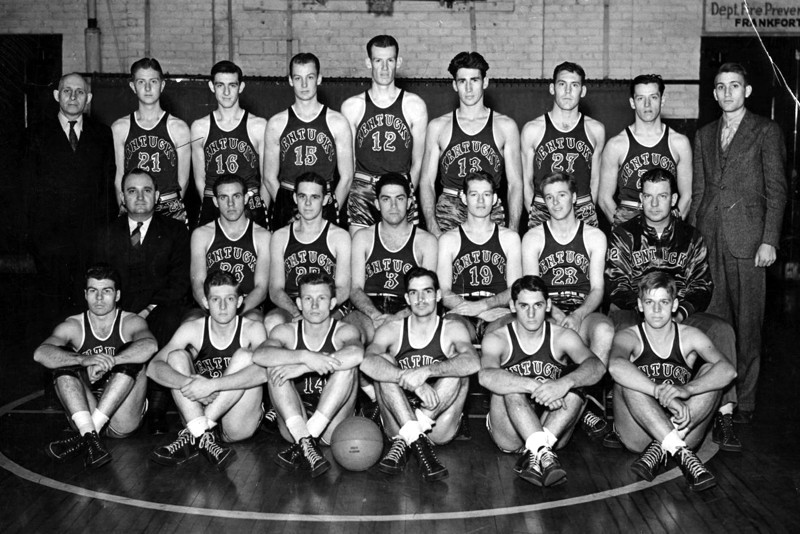 |
1938-39 Squad |
Front Row (l to r): Ernie Jefferson, Donald Orme, Elmo Head, Waller White, Carl Combs, Lee Huber |
![]()
Season Review - Basketball by Joe Creason (Kentuckian)
Topping a banner year by annexing the championship of the Southeastern Conference, Coach Adolph Rupp's 1938-39 basketball creation presented Kentucky cage customers with one of the greatest teams since the days of Aggie Sale.
Against the cream of competition from the East, South and Midwest, the Wildcats proved their championship caliber by rolling up 13 wins in 17 times out.
The season marked the 8th anniversary of Coach Rupp's appearance on the campus. In the days B. R. (Before Rupp) basketball and Chinese checkers held about the same athletic rating at Kentucky. Not enough customers attended the games to furnish sides for a fast game of two-eyed cat. The teams were groping along with mediocre success, playing the slow breaking, listless game that is so characteristic of Southern basketball.
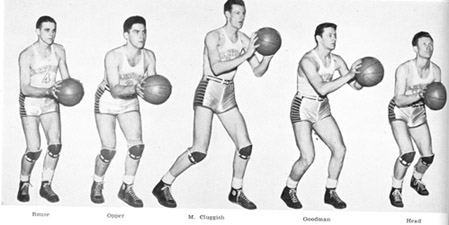 |
Then in 1931, from the University of Kansas where he was considered one of the best players developed under the famous Dr. Phog Alien, via two small high schools, Mr. Rupp, like a prophet of old, appeared to lead Kentucky out of the basketball wilderness. The bleacher Pinkertons' shook their heads and said that trying to revive basketball was as impossible as trying to put Niagara through a soda straw. The first Rupp coached team turned in a report card of 15 wins against 3 losses and the campus rubbed its basketball-drowsy eyes. But in 1932, when 15 of 17 games were won, the fans were thoroughly aroused and went after the sport like parched throats go for ice water.
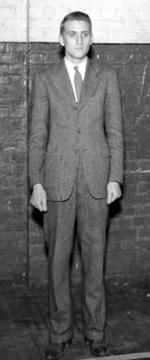 |
But to a forgotten man, Freshman Coach Paul McBrayer, goes much of the credit for Kentucky's rocketing toward the top. Himself one of the greatest guards to ever wear the Blue and White, McBrayer returned to his alma mater as frosh mentor in 1934 and since that time his teams have rivaled even the success of the varsity.
From the time that the first call was made for team candidates it was evident that the Wildcats would be hotter on the trail of the Conference title than a pack of bloodhounds after a jail breaker. Returning lettermen numbered Captain-elect Bernie Opper, Homer Thompson, Fred Curtis and Elmo Head, all seniors, and Marion Cluggish, Layton Rouse and James Goodman, junior members of the squad. A full month of practice was furrowed into the Wildcats' brows before the team, enrolling the veterans and three newcomers, Lee Huber, Keith Farnsley, and Harry Denham, set out for the cage wars.
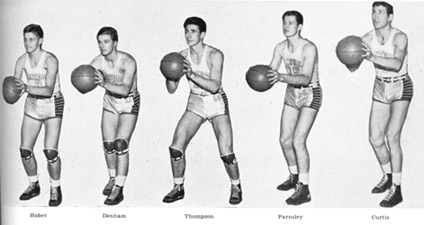 |
The opening game found Kentucky rolling over Georgetown College by a 39-19 score in a thrill-void game in Alumni Gym before 3,000 fans.
The only pleasing factor of the game, since the famed Wildcat offense was colder than an eskimo's kiss, was Kentucky's iron-bound defense that held Georgetown to a total of five field goals during the entire game.
Led by Curtis, Opper and Farnsley, the Wildcats crucified Kentucky Wesleyan College on a 58-18 cross in the second game of the season. So errorless did the Cats play that Wesleyan was not granted a shot at the goal during the first 8 minutes of the game.
In a game that was termed the acid test, Kentucky operated an offense that was hotter than a burglar's pistol to smother the University of Cincinnati by a 44-27 score in their third game of the campaign. Curtis again led the scoring steeplechase.
Rolling out points faster than a streamlined adding machine Kentucky climbed all over Washington and Lee with a 67-47 score for the fourth straight win of the season. Curtis and Thompson, exploiting the jump and hook shots to their fullest extent, seared the hemp with 17 and 16 points, respectively. After holding a 25 point advantage at intermission the Cats eased up and allowed the Generals to fatten their score late in the game.
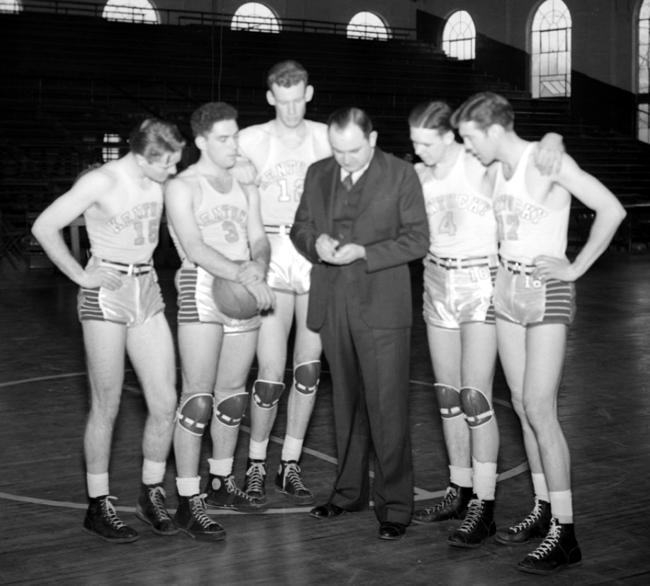 |
About this time the Cats were being touted as invincible. But then the team hit a slump that sent it toppling from the heights like a dynamited smoke stack. After losing four of the next five games the season began to look as crazy as Cousin Minnie's quilt. Kentucky hit the toboggan January 4 when, after an absence of three years, Coach Rupp returned with the team to Madison Square Garden, New York City. This time the foe was Long Island University who turned the Cats Christmas cheer into Bronx cheering.
Unbeaten in 22 games the New York team fired a homicide offense at the Cats that brought a 52-34 win. Throughout the game Kentucky, as far off as a four sided triangle, failed miserably to show its true class. Cluggish and Curtis, with 9 points each, led the scorers for Kentucky. The game was played before an audience of 14,000 customers.
 |
Kentucky's loss complex became thicker than smoke in a Harlem night club when Notre Dame, cashing in on 22 out of 24 foul shots, nipped the Cats by 42-37 in a game that provided more thrills than a dime detective magazine. Played in the Louisville Armory, the game drew 7,500 customers past the box-office, the largest crowd ever to see a basketball game in the state. In field goals the Cats held a 14-10 advantage but the phenomenal success of the Irish at the foul line provided the margin of victory. Curtis led the scoring with 11 points while Rouse finished second high with 9.
Returning to Alumni Gym the Wildcats treated 4,000 fans to a miserable demonstration as they dropped a 30-29 decision to Tennessee. Despite the warmed-over appearance of the offense, Kentucky held a 10 point lead at half time but fiddled the final half while the Volunteer attack burned.
The third successive loss, a new high for Rupp, came when Alabama trapped the Blues by 41-38 in Birmingham. With Cluggish cramming 18 points through the net, Kentucky slapped Vanderbilt by 51-37 in the final stand of the abbreviated Southern jaunt.
The fans, who had once predicted great things of the team, shook their heads and groaned. The outlook was indeed blacker than a war cloud. But behind the scenes something was happening. In their next game the Blues looked like an entirely different unit. From the bunch that previously had been inclined to loaf, the Wildcats were transformed into a serious minded team with but one object in mind - to win. And win they did - 7 straight times.
An offense that was as tireless and relentless as Old Man River operated behind a vacuum tight defense that brought a 37-31 win over Marquette. Came next a 41-31 win over Xavier, followed by revenge on Alabama by a 45-27 margin. Then Mississippi State was collared by 39-28 and Tennessee meat tasted by 36-34. With Curtis sacking up 19 points, Xavier was again looted and this time a 43-23 win was crated off. The regular playing season ended with a 52-27 win over Vanderbilt.
 |
Sports writers covering the tournament honored Opper's play by unanimously selecting him, for the second year, as an All-Conference guard. Thompson and Farnsley were named for the second team while Huber, Rouse, and Cluggish received honorable mentions. Opper followed this honor by being selected for All-America second team honors by the NEA newspaper service.
At the annual basketball banquet, with Governor A. B. Chandler as the principal speaker, James Goodman, junior forward from Paris, Kentucky, was selected to succeed Opper as net captain. Letters were awarded to the 10 members of the tournament squad. At a later banquet, given by Lexington Mayor Reed Wilson, each member of the squad was presented with a miniature key to the city.
With but four of the Conference championship squad walking the June diploma plank, Kentucky's strangle hold on Southern basketball seems secure for at least another season. Up for varsity berths on the 1939 team are Walter White, Carl Staker, Hoot Combs, Donald Orme, and Stanley Cluggish, all of whom were this year members of the "lost battalion." The battalion was christened by Coach Rupp and was composed of men who, although able enough to make ordinary teams, were withheld from competition to make them eligible for three more full seasons c.f. varsity play.
![]()